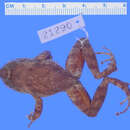Description
provided by AmphibiaWeb articles
Males 19.4-25.5 mm SVL, females 25.0-37.1 mm SVL. Moderately long snout, nearly rounded to rounded in dorsal view, rounded to nearly vertical in profile, with angular canthus and concave loreal region. Top of head flat. Pupil horizontally elliptical. Tympanum distinct in males, indistinct in females, with supratympanic fold obscuring the top of the tympanum. Fingers unwebbed and have expanded discs, with that of Finger III 1.3-2.0x digit width. Finger II is longer than or equal to Finger I. Toes are basally webbed, with expanded discs (Toe IV disc is 1.3-2.0x digit width) and have lateral keels. No inner tarsal fold is present. Dorsum tuberculate, ventrum nearly smooth or slightly wrinkled. Pollex not enlarged. Males have nuptial pads bearing colorless, granular asperities on the thumbs, and vocal slits. Males also have a single, median, subgular vocal sac that is not visible externally (McCranie and Wilson 2002).Pale olive dorsally with body having dark olive flecking and hindlimbs having dark olive crossbars. Venter yellow with brown flecks. Groin and underside of thighs yellowish orange with brown flecks (McCranie and Wilson 2002).
Distribution and Habitat
provided by AmphibiaWeb articles
Endemic to west and northwest Honduras at elevations ranging from 1,050 to 1,720 m, in Sierra Espíritu Santo and Sierra Omoa. C. milesi has been recorded from Cerro Azul in Copán Departmento and Montana del Cusuco and Montana del Merendon in the Departmento of Cortes. This leaf-litter species was located alongside streams in premontane and lower montane forest (McCranie et al. 2002).
Life History, Abundance, Activity, and Special Behaviors
provided by AmphibiaWeb articles
This species was once prevalent. Significant declines were observed in the mid-1980s. Between 1992 and 1998 extensive surveys were undertaken to locate this species, which failed, and Craugastor milesi is now considered extinct. This species bred through direct development (Stuart et al. 2008). Adults were found along small montane streams at night and sheltering under streamside rocks during the day. Juveniles were active both by day and by night (McCranie and Wilson 2002).
Life History, Abundance, Activity, and Special Behaviors
provided by AmphibiaWeb articles
Habitat loss resulting from the conversion of forest areas to agricultural use is thought to have been a major factor in this species' extinction. However, this species also disappeared from protected cloudforest habitat within Cusuco National Park, as well as from two Copán localities, likely from the effects of chytridiomycosis (McCranie and Wilson 2002; Stuart et al. 2008). This disappearance of C. milesi has occurred in conjunction with the extirpation of all Honduran streamside Craugastor populations from 900 m asl and higher (McCranie and Wilson 2002). The presence of Batrachochytrium dendrobatidis has now been confirmed in multiple anuran species in Cusuco National Park, where amphibian population declines have been observed (Kolby et al. 2009).
Craugastor milesi
provided by wikipedia EN
- license
- cc-by-sa-3.0
- copyright
- Wikipedia authors and editors
Craugastor milesi: Brief Summary
provided by wikipedia EN
Craugastor milesi is a species of frog in the family Craugastoridae. It is endemic to Honduras. Its natural habitats are subtropical or tropical moist montane forests and rivers. It is threatened by habitat loss.
- license
- cc-by-sa-3.0
- copyright
- Wikipedia authors and editors

